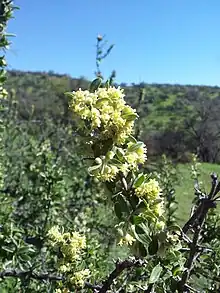| Trevoa | |
|---|---|
 | |
| Trevoa quinquenervia | |
| Scientific classification | |
| Kingdom: | Plantae |
| Clade: | Tracheophytes |
| Clade: | Angiosperms |
| Clade: | Eudicots |
| Clade: | Rosids |
| Order: | Rosales |
| Family: | Rhamnaceae |
| Tribe: | Colletieae |
| Genus: | Trevoa Miers ex Hook. |
| Synonyms | |
| |
Trevoa is a genus of actinorhizal plants; these dicotyledon flora are trees or small shrubs. The genus was first proposed by Miers in 1825, but was not fully described until 1830 by Sir William Jackson Hooker.[1] Genus members are notable for their ability to fix nitrogen. Species of this genus are generally found in the near coastal forests and arid shrubland of South America. Some species are localized in the mountains of central Chile; for example, the species Trevoa trinervis occurs in the La Campana National Park[2] and other proximate areas of central Chile.
Along with some related plants in the family Rhamnaceae, they fix nitrogen via root nodules which contain Frankia bacteria.[3] Other nitrogen-fixing genera in this family include Ceanothus, Colletia, Discaria, Kentrothamnus, and Retanilla.[4]
Taxonomy
The botanist Karl Friedrich Reiche, publishing in the years 1894–1911, recognized 6 species.[5] Currently there are five recognized species in the genus.
Species
Trevoa comprises the following species:[6][7]
- Trevoa campanulata Reiche
- Trevoa closiana Miers
- Trevoa glauca Reiche
- Trevoa quinquenervia Gillies & Hook. (syn. Talguenea quinquenervia[8])
- Trevoa spinifer Escal.
Species names with uncertain taxonomic status
The status of the following species and hybrids is unresolved:[7]
- Trevoa berteroniana Steud.
- Trevoa tenuis Miers
Formerly placed here
- Trevoa trinervis Miers = Retanilla trinervia (Gillies & Hook.) Hook. & Arn.[9]
Notes
- ↑ J. Miers. 1860
- ↑ C. Michael Hogan. 2008
- ↑ Michael L. Clawson; Margarita Carú & David R. Benson (September 1998), "Diversity of Frankia Strains in Root Nodules of Plants from the Families Elaeagnaceae and Rhamnaceae", Appl Environ Microbiol, 64 (9): 3539–3543, doi:10.1128/AEM.64.9.3539-3543.1998, PMC 106764, PMID 9726914
- ↑ James E. Richardson; Michael F. Fay; Quentin C. B. Cronk; Diane Bowman & Mark W. Chase (2000), "A phylogenetic analysis of Rhamnaceae using rbcL and trnL-F plastid DNA sequences", American Journal of Botany, 87 (9): 1309–1324, doi:10.2307/2656724, JSTOR 2656724
- ↑ Karl Friedrich Reiche, "Trevoa Miers.", Estudios críticos de la Flora de Chile
- ↑ Govaerts R. "Trevoa Miers ex Hook.". Plants of the World Online. Board of Trustees of the Royal Botanic Gardens, Kew. Retrieved 15 December 2020.
- 1 2 "The Plant List entry for Trevoa". The Plant List, v.1.1. Royal Botanic Gardens, Kew and the Missouri Botanical Garden. September 2013. Retrieved 15 December 2020.
- ↑ Diego Medan; Ana C. D'Ambrogio (1998), "Reproductive biology of the andromonoecious shrub Trevoa quinquenervia (Rhamnaceae)", Botanical Journal of the Linnean Society, 126 (3): 191, doi:10.1111/j.1095-8339.1998.tb02526.x, ISSN 0024-4074
- ↑ "Trevoa trinervis Miers". The Plant List (2010). Retrieved 2 January 2014.
References
- C. Michael Hogan. 2008. Chilean Wine Palm: Jubaea chilensis, GlobalTwitcher.com, ed. N. Stromberg
- J. Miers. 1860. The Annals and Magazine of Natural History: Including Zoology, Botany, and Geology, Published by Taylor and Francis, ser.3: v.5, p 487